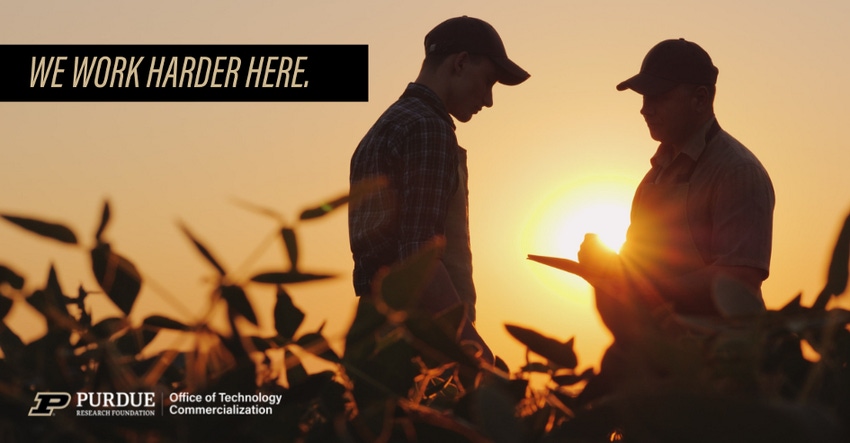Nine innovations created by Purdue University researchers
Includes certification of grass-fed quality characteristics of beef and determining pig fertility potential at weaning.
September 2, 2022

Purdue University researchers have developed several innovations in the agriculture field. There are almost 60 available to bring to market through licensing or other commercialization agreements with the Purdue Research Foundation Office of Technology Commercialization.
Here are nine of those innovations:
Certification of grass-fed quality characteristics of beef
Researchers at Purdue University and the University of Sao Paulo have developed a method to determine the type of feed provided to the cattle. Grass-fed beef has been recognized as healthier than grain-fed beef. However, there has been no optimum way to independently validate the grass-fed claim. The Purdue and Sao Paulo researchers’ method uses a lipid panel coupled with mass spectrometry to identify the metabolized products of grass and grain, allowing determination of whether the cows were fed grass or grain.
Determining fertility potential at weaning
Researchers at Purdue University have developed a new method for determining fertility potential of young female pigs at weaning using lipidome profiles. Currently, around 50% of young female pigs selected at three weeks of age are infertile by the time they reach 32 weeks of age. The new technique created by Purdue researchers can identify gilts to replace sows in a breeding herd and reduce the age of identification by six months, allowing for a more cost-effective solution for breeding selection.
Non-destructive robotic root imaging system for plant health
Researchers at Purdue University have created a low-cost robotic arm with a camera extension that images entire areas around soil. The system identifies roots, saves them computationally by location, and reconstructs size, shape and depth in 3D. This method is non-destructive and quickly assists in recognizing plant conditions as well as growth patterns. The technique is applicable to breeding, research, farming and horticulture.
Online forest management portal
Researchers at Purdue University have developed a method to determine the location, structural characteristics, and health of each tree in a forest and easily access the information. Current methods to determine tree characteristics in a forest are based on manually sampling a subset of the trees and assuming the information is representative of the whole forest. The Purdue researchers’ method involves generating point clouds with stationary terrestrial scanners, mobile terrestrial scanners, UAV-mounted LiDAR units and/or UAV imagery and uploading the information to an online forest management portal. The online portal uses the point clouds to determine the location, structural characteristics and health of each tree in a forest.
Purdue apple varieties
Purdue University began breeding apples in 1945 and now has about 48 varieties. The apple-breeding program started in 1934 as part of a Purdue, Rutgers University and University of Illinois, or PRI, program to develop disease-resistant apples. Sixteen of the Purdue apple varieties are being grown or tested in the United States. Europe, Canada, Chile, South Africa, Turkey, New Zealand, Australia and elsewhere around the world. Many are being used as "parents" in breeding programs. Some of the more popular Purdue apple breeds include GoldRush, which has a crisp, tart flavor with long storage that has become a cult apple; Crimson Crisp, a crunchy, spicy apple; and Pixie Crunch, an apple ideal for kids because of its smaller size.
Regulation of plant nodulation by Rhizobial tRNA-derived small RNAs
Nitrogen-fixation is often the limiting factor for plant growth and crop yield because nodulation is hindered by inefficient interactions between Rhizobial bacteria and plants. This technology from Purdue University researchers uses tRNA-derived small RNAs to increase root hair curling and nodule number in legumes. Through gene editing of plants with the tRNA-derived small RNAs, the number of productive Rhizobial infections dramatically increased. Genetic engineering of plants to promote nodulation has applications in enhancing nitrogen-fixation in legumes and in extending nitrogen fixation capabilities to non-legumes.
Scab-resistant apple variety
Purdue University researchers have developed a new variety of apple. It is small, typically less than 2.75 inches; has dark red skin; a smooth finish; and coarse, grained flesh. It is crisp, sprightly, juicy and sweet. It is usually harvested in late October. Scab lesions have not been observed on the leaves or fruit of this new variety.
Sensing dust concentration through a mobile application
Researchers at Purdue University have developed a mobile phone application using OpenCV algorithms that detect dust concentration. Dust builds up in agricultural and manufacturing settings, causing health hazards to employees and posing risk of exploding in combination with aerosols. Current technology for detecting dust levels is inconvenient because it is expensive, difficult to install in a workspace, and separates dust matter into multiple filters which must then be weighed and further manipulated for analysis. The mobile app created by Purdue University uses a smartphone camera to image and sense dust as well as accurately distinguish it from normal background noise. In testing, the algorithm successfully recognizes 95% of saw dust and 93% of cornstarch particulates in the air.
Use of sweet corn as a sugar substitute
Researchers at Purdue University have extracted a natural and digestible sugar substitute from sweet corn. Sugar over-consumption is a problem worldwide. Sugar substitutes such as polydextrose, allulose, sugar alcohols, oligosaccharides and non-starch polysaccharides are non-digestible. The Purdue researchers' sugar substitute is extracted from sweet corn and is digestible without laxative effect when used in a large quantity in food. The corn sugar has a high water-binding capability, which decreases spoilage rates and increase shelf-life.
Source: Purdue Research Foundation, which is solely responsible for the information provided, and wholly owns the information. Informa Business Media and all its subsidiaries are not responsible for any of the content contained in this information asset.
You May Also Like



